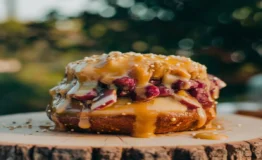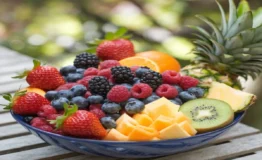Crème brûlée is an elegant and indulgent dessert that has long been a favorite in both upscale restaurants and home kitchens. With its rich custard base and crisp, caramelized sugar topping, crème brûlée is the epitome of sophistication in the dessert world. However, many people find this classic French treat intimidating to make. What is the secret to achieving the perfect crème brûlée? Let’s explore the tips, techniques, and expert advice that will help you master this delicious dessert.
What Makes Crème Brûlée Unique?
Crème brûlée stands out among desserts due to its contrast in textures and flavors. The smooth and creamy custard provides a delightful balance to the crunchy caramelized sugar top. This dessert is often infused with vanilla for a classic flavor, but variations such as chocolate and fruit-infused versions add a unique twist. The key to making a great crème brûlée lies in achieving the perfect balance between the creamy interior and the crispy exterior.
The challenge of creating this balance is what makes crème brûlée both exciting and nerve-wracking for home cooks. However, with the right techniques, anyone can make a restaurant-quality crème brûlée in their own kitchen. Mastering the custard is the first step, and understanding the secrets to caramelizing sugar without burning it is the final touch. For those interested in exploring creative takes on this dessert, here’s a guide to creative crème brûlée variations.
Essential Ingredients in Crème Brûlée
While crème brûlée may seem complicated, it’s made with just a few simple ingredients. These key components, when combined correctly, create the luscious texture and rich flavor that defines this dessert.
- Egg Yolks: Fresh, high-quality egg yolks are essential for creating a rich and creamy custard. The yolks give the dessert its signature velvety texture.
- Heavy Cream: Heavy cream provides the smoothness and richness that make crème brûlée irresistible. Its high fat content is crucial for a perfect custard.
- Sugar: Sugar plays a dual role in this dessert. It is mixed into the custard to provide sweetness, and it is also used to create the crunchy caramelized top.
- Vanilla: The classic crème brûlée flavor comes from vanilla extract or vanilla beans. Using high-quality vanilla elevates the overall taste of the dessert.
These ingredients work together to form the base of a crème brûlée. To enhance the flavors even further, consider using fresh vanilla beans or vanilla bean paste. If you’re looking for alternative flavors or want to learn more about the science behind caramelization, check out this guide to achieving the perfect caramelization.
The Secret to Perfect Custard
Achieving the perfect custard is the heart of making a successful crème brûlée. Here are some key techniques that will help you create a smooth, rich custard every time.
- Tempering Egg Yolks: The process of tempering is crucial to prevent the eggs from curdling. This involves slowly adding hot cream to the egg yolks while whisking continuously. By gradually raising the temperature of the yolks, you avoid the risk of turning them into scrambled eggs.
- Achieving the Right Consistency: The ideal crème brûlée custard should be creamy, yet firm enough to hold its shape when served. Bake the custard until it is just set, with a slight jiggle in the center. Overbaking can result in a dense, rubbery texture.
- Scalding the Cream: Scalding the heavy cream—heating it just until bubbles form around the edges—helps to infuse the flavor of the vanilla and ensures a smooth consistency when combined with the egg yolks. Be careful not to let the cream boil, as this can affect the final texture of the custard.
Baking Techniques: What is the secret to crème brûlée?
Once your custard is prepared, the next step is baking. Proper baking techniques are key to ensuring that your crème brûlée cooks evenly and achieves the desired texture.
- Baking in a Water Bath: One of the secrets to perfect crème brûlée is baking the custard in a water bath. This technique involves placing the ramekins in a larger pan filled with hot water, which helps regulate the temperature and ensures even cooking. The water bath prevents the custard from curdling and cracking by providing gentle, consistent heat.
- Positioning in the Oven: It’s important to bake the custards in the center of the oven, where heat distribution is most even. If the ramekins are too close to the top, the surface may brown too quickly, while the bottom remains undercooked. Conversely, placing the ramekins too close to the bottom of the oven can result in overcooking the base.
- Avoiding Overbaking: The custard is done when it’s set but still has a slight jiggle in the center. Overbaking will result in a texture that is too firm, taking away from the smooth, luxurious mouthfeel that crème brûlée is known for.
Creating the Perfect Caramelized Topping
The finishing touch on any crème brûlée is the caramelized sugar topping. Getting this right can be tricky, but with the right technique, you can achieve that perfect crisp layer every time.
- Choosing the Right Sugar: While white sugar is the standard for caramelizing, some chefs prefer using a mixture of white and brown sugar. Brown sugar can add a deeper flavor and a darker color to the caramelized layer. However, it also burns more easily, so careful attention is needed.
- Using a Kitchen Torch: The best way to caramelize the sugar is with a kitchen torch. Hold the torch a few inches above the sugar and move it in small circles to ensure even caramelization. The goal is to achieve a golden-brown color without burning the sugar, which can result in a bitter taste.
- Alternative Methods: If you don’t have a kitchen torch, you can use your oven’s broiler. Place the ramekins under the broiler for a few minutes, watching closely to avoid burning the sugar. Keep in mind that this method can be less precise than using a torch.
Cooling and Chilling for Best Results
Cooling and chilling are essential steps in ensuring your crème brûlée has the right texture and flavor. Rushing through these steps can compromise the final result.
- Cooling in the Water Bath: After the custards are done baking, let them cool in the water bath for about 30 minutes. This gradual cooling process helps prevent the custard from cracking.
- Chilling Overnight: For the best results, chill your crème brûlée in the refrigerator for at least 4 hours, or preferably overnight. This allows the custard to fully set and develop its creamy texture.
- Storing Crème Brûlée: Once chilled, crème brûlée can be stored in the refrigerator for up to 2 days. Cover the ramekins with plastic wrap to prevent the custard from drying out. When ready to serve, caramelize the sugar topping just before serving to ensure it remains crisp.
Common Mistakes and Expert Tips
Even experienced bakers can run into issues when making crème brûlée. Here are some common mistakes and expert tips to help you avoid them:
- Overcooking: Overbaking can result in a rubbery texture. To avoid this, remove the custards from the oven when they still have a slight jiggle in the center.
- Burning the Sugar: When using a kitchen torch, be sure to keep the flame moving to avoid burning the sugar. A burned topping can give your dessert a bitter taste.
- Skipping the Water Bath: The water bath is crucial for even cooking and preventing cracks in the custard. Skipping this step can lead to unevenly cooked custard and an unpleasant texture.
Popular Variations of Crème Brûlée
While classic vanilla crème brûlée is a timeless favorite, there are many ways to put your own spin on this dessert. Here are some popular variations:
- Chocolate Crème Brûlée: Add melted chocolate to the custard mixture for a richer, more indulgent flavor.
- Fruit-Infused Crème Brûlée: Infuse the cream with citrus zest or add fresh berries for a fruity twist.
- Lavender Crème Brûlée: Add dried lavender to the cream for a floral note that pairs beautifully with the custard.
Frequently Asked Questions (FAQs)
What is the secret to a smooth crème brûlée custard? The secret is to temper the egg yolks by slowly adding the hot cream while whisking continuously. This prevents the yolks from curdling and ensures a smooth, creamy custard.
Can you make crème brûlée without a torch? Yes, you can use your oven’s broiler to caramelize the sugar. However, a kitchen torch provides more precise control and is less likely to burn the sugar.
Why does my crème brûlée have a rubbery texture? A rubbery texture is often the result of overbaking. Make sure to remove the custard from the oven when it still has a slight jiggle in the center, as it will continue to set as it cools.
How do I prevent the sugar from burning? When using a kitchen torch, keep the flame moving in small circles to evenly caramelize the sugar without burning it. If using a broiler, watch the custards closely to avoid burning.
Can crème brûlée be made in advance? Yes, you can prepare the custard in advance and refrigerate it for up to 2 days. Caramelize the sugar topping just before serving for the best texture.
Final Thoughts
Crème brûlée may seem like a complex dessert, but with the right techniques and attention to detail, it can be easily mastered. The secret to a perfect crème brûlée lies in balancing the smooth, creamy custard with the crisp, caramelized sugar topping. By following these tips and avoiding common mistakes, you can create a dessert that is sure to impress your guests.
Whether you stick to the classic recipe or experiment with variations, crème brûlée is a dessert that will never go out of style. With its rich flavor and elegant presentation, it’s no wonder that this French classic remains a favorite among dessert lovers around the world.







